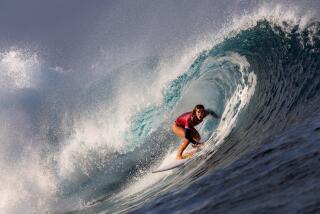Youths Learn to Go With the Flow at Ocean
- Share via
White-blond hair tucked behind her ears, Mary Setterholm stood on the wet sand near El Segundo and stripped down to a swimsuit, ready to plunge into the gentle waves after her charges.
Ruth Palacios speaks mostly Spanish and looked ill at ease in her borrowed wetsuit. A dozen other children ran past her into the waves, splashing and shouting. Ruth, 7, hesitated on the sand, struggling to find her inner surfer girl.
“She’s a little bit scared, and that’s OK,” said Setterholm, who at age 17 won the 1968 U.S. Women’s Surfing Championships and now runs surf camps along California’s coast as well as a school for surfers. “The idea is to ease them into the sea.”
That Ruth was lying like a beached whale on her tummy, splashing herself and calling “Mira! Mira!” (Look! Look!) to her friends, was plenty of progress for some kids by only week two, Setterholm said, watching with amusement.
“Woo-woo!” she hollered, applauding the little girl.
For 11 weeks during the summer, children from inland L.A. have the chance to take a bus to the shore and spend five hours learning to ride waves. Setterholm and four instructors work with the children at the outings.
The point of Setterholm’s project, called LA Surf Bus, is to give kids who have had little exposure to the ocean and beach culture a chance to enjoy it.
So on Tuesdays, Wednesdays and Thursdays from the middle of June until the end of August, Setterholm and her team pick up kids at three locations and travel by bus to either Santa Monica or El Segundo-area beaches.
Setterholm pays for much of the project with revenue from her Surf Academy. L.A. County Supervisor Don Knabe helped pay for the bus transportation, and wetsuit manufacturer Bodyglove donated surfboards, wetsuits and other equipment.
The first week started slowly, with the focus on kids playing beach games to adjust to the ocean and waves. The instructors say that approach works especially well with the fainthearted. The kids, ages 7 to 17, learned about the power of ocean currents by walking with and against one. They learned that a wave breaks roughly every 10 seconds, allowing them to brace for it and avoid being knocked over.
One morning, most of the youths aboard the bus were from a program called Dig for Kids in Carson. Joining them on the beach were several children of Manhattan Beach domestics, including Ruth.
Because almost all of them were new to surfing, the children were taught silly games and water safety tips. By 3 p.m., they had been returned to their starting points at downtown L.A.’s MacArthur Park, the L.A. Episcopal Diocese in Echo Park and Carson High School.
By the middle of July, about 100 children were attending the camp each week. Setterholm said there’s room for more.
First, the children learn how a surfboard works.
In a wetsuit and wearing a tan hat tied under her chin, instructor Shelly Baldi knelt at the water’s edge and explained the anatomy of a neon blue board.
“This is the tail. This is the nose. This is the top, or deck. These are the rails, or the sides,” she said, little heads bobbing back at her. “You always want to have the bottom and the fins down, and the top up.”
Zyra Paniel, 10, was a quick and enthusiastic learner.
Fresh out of fourth grade, Zyra said she’d been dreaming her whole life of surfing, practicing for the real thing by lining up pillows on the floor and pretending they were a surfboard on which she was riding.
“I thought this would be my only chance to learn,” she said, long wet strands of hair clinging to her cheeks. She had just surfed her first wave and was beaming.
Setterholm strolled up. “Wow! Are you stoked?” she asked Zyra, who looked puzzled.
Zyra: “What does that mean?”
Setterholm: “Psyched, are you psyched?”
Zyra: “Oh, like am I excited?”
Setterholm: “Yeah. Yeah. Can you say, ‘I’m stoked?’ ”
Zyra: “Uh,” she hesitated, “I’m stoked?”
Setterholm threw back her head and laughed with pleasure. “Yes!”
The lingo isn’t all the children learn about beach culture. There’s the junk food (chili cheese fries from the beach snack shack) and the towel change (wherein the surfer slithers out of wet swimsuit or wetsuit on a public beach).
“The towel change, we have to build up to later,” Setterholm said with a grin.
Among the instructors are Nicole Goodwin, 25, and Steven Burnett, 20, both African American L.A. residents who were students of Setterholm, who said she thinks having instructors who defy the white, blond surfer stereotype helps make many children more comfortable.
Climbing out of the waves in a wetsuit, John Weigett, 52, watched the kids joyously playing nearby. He is a surfer and a pastor at the New Life Christian Center in Carson. His grandson was in Setterholm’s group.
“Mary’s got a big heart -- a big heart for the kids,” Weigett said. “One little girl here told me her parents never spend any time with her because they are always working, two jobs each, and she never gets to be outside. So this is just a great opportunity for her.... And you sure can’t beat the price -- free.”
*
Readers interested in LA Surf Bus can inquire at Surf Academy, (310) 372-2790.
More to Read
Sign up for The Wild
We’ll help you find the best places to hike, bike and run, as well as the perfect silent spots for meditation and yoga.
You may occasionally receive promotional content from the Los Angeles Times.






